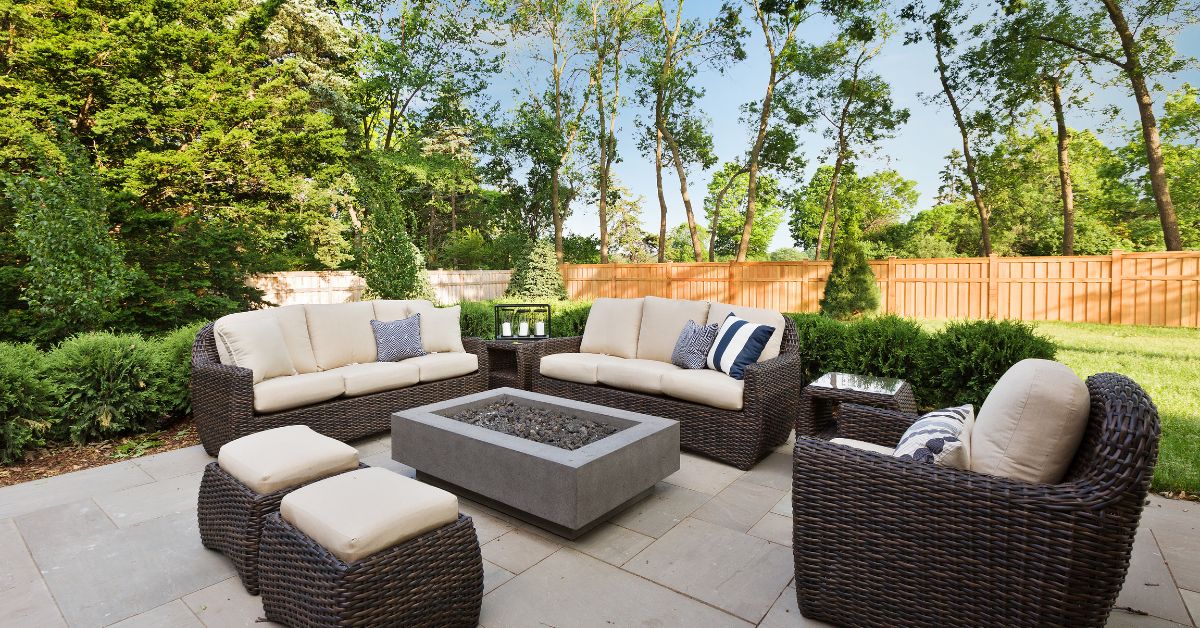Garden design has come a long way from simple paving and a couple of folding chairs. These days, outdoor spaces are being treated with the same level of care and design ambition as indoor rooms. Homeowners are investing in their backyards not just for function, but for mood, lifestyle, and value. Think curated materials, immersive features, and timeless layouts.
Let’s walk through the standout luxury trends reshaping outdoor spaces this year, from bold design choices to subtle architectural shifts. These are the elements that elevate a space from nice to exceptional.
1. Structured Mediterranean style
Mediterranean influences have been around for a while, but this year they’re getting a refined makeover. Instead of rustic finishes and mismatched textures, the look now leans polished. We’re seeing more symmetry, tighter planting schemes, and simplified material palettes. Think pale limestone pavers, boxwood hedging, and aged olive trees placed with intent.
This elevated version creates a sense of calm and structure. It’s especially effective when combined with patios and pergolas, which anchor the space and offer a balance of form and function. The cool-toned surfaces contrast beautifully with the warmth of timber and terracotta, creating a setting that feels both grounded and luxurious.
2. Water features that feel architectural
Forget noisy fountains or awkward birdbaths. The current trend leans towards water features that act as design centrepieces rather than background noise. These are sculptural, often linear or geometric, and made using concrete, stone, or steel.
The aim is to add atmosphere without dominating the space. Subtle overflow edges, dark interiors that reflect the sky, and still pools are all gaining traction. Some are integrated into pathways or borders, blurring the line between landscaping and art. When lit at night, they add depth and calm that’s hard to replicate with anything else.
3. Monochrome planting schemes
Bold colour in the garden is taking a step back. High-end outdoor spaces are being planted with a tighter colour range, often sticking to one tone family. Greens in all their shades are the dominant choice, with emphasis on structure, texture, and shape over bright flowers.
This doesn’t mean the garden lacks interest. It’s just a different type of appeal. You might see layers of silvery foliage beside glossy evergreens, or different heights and leaf forms playing off one another. This approach pairs beautifully with minimalist furniture and hardscaping, offering a more cohesive visual experience.
4. Seamless indoor-outdoor transitions
Luxury outdoor design is no longer treated as separate from the main house. The most impressive projects now blur the lines between indoor and outdoor living. Floor levels are matched, materials often continue between inside and out, and sliding or folding walls open to completely remove any barrier.
Textures are coordinated, even when they aren’t identical. For example, a timber floor might meet a matching deck, or a polished concrete kitchen opens straight onto honed pavers outside. Lighting, too, is designed with continuity in mind. This approach works particularly well in homes with generous glazing, letting the outdoors play a constant role in the home’s atmosphere.
5. Sunken lounge areas
Sunken spaces add drama and intimacy, especially when used for lounge zones or fire pits. They work best in larger gardens where there’s room to shift ground levels. Done well, they feel like a retreat within the garden itself.
Designers are favouring clean lines and built-in seating, often with cushions upholstered in high-end outdoor fabric. Materials like concrete, tumbled stone, or smooth brickwork are being chosen over traditional decking. Integrated fire elements, lighting strips, and weatherproof audio are turning these spaces into entertainment hubs, day or night.
6. Garden zones with purpose
Gone are the days of one big lawn and a few border plants. Today’s luxury outdoor spaces are broken into zones, each with its own purpose and style. Some might be open and social, while others are quiet, shaded, or even hidden.
Here’s how these zones are typically used:
- Dining zone – Usually near the house, often under cover
- Lounge or fire area – More relaxed, often centred around a feature
- Private retreat – Tucked away, ideal for reading or morning coffee
- Green space – Could be a lawn or planted area, used to balance built structures
- Pool area – Designed with daybeds, storage, and a sense of separation
- Productive garden – For herbs or edible plants, styled to blend with the rest
- Pathways and connectors – Designed as part of the experience, not just function
These zones are often defined using subtle changes in material, planting height, or lighting, so the space feels cohesive rather than divided.
7. Bespoke lighting design
Lighting has moved well beyond fairy lights and step markers. Now, it’s a fully integrated part of outdoor architecture. A considered lighting plan adds drama, improves safety, and extends the usability of the garden long after dark.
Designers are using a mix of soft uplighting on feature plants, under-bench strips, and recessed path lights to define shapes and textures. Warm tones are preferred, and dimmable settings give more control. Some lighting is built right into stone walls or pergola beams, meaning it looks intentional and architectural rather than added on as an afterthought.
8. Natural textures with a luxury twist
The materials being used in high-end landscaping still take their cues from nature, but the finish and detailing are what lift them into the luxury category. For example:
- Stone – Honed rather than rough, often oversized and custom-cut
- Timber – Sustainably sourced, usually with a smooth or wire-brushed surface
- Concrete – Pigmented, polished, or board-formed to add depth
- Metal – Powder-coated or aged bronze, rarely raw
These textures are paired carefully, chosen not just for their visual appeal but for how they feel underfoot and how they age over time. The result is a space that feels expensive without being loud.
9. Minimal maintenance without compromise
Luxury doesn’t mean high effort. In fact, many of the latest designs aim to reduce maintenance while still offering visual impact. That means:
- Using native or climate-adapted plants that thrive without fuss
- Incorporating automated irrigation and lighting systems
- Choosing hardwearing surfaces that don’t need sealing or scrubbing
- Designing storage cleverly, so cushions and furniture can be protected easily
It’s about achieving a lifestyle that feels indulgent, without requiring constant upkeep.
Designed to Be Lived In
Luxury outdoor spaces today are more than curated snapshots for social media or architectural portfolios. They’re places built for real life: for slowing down, entertaining well, and appreciating beauty on your doorstep. Every detail, from layout to materials, is considered with the goal of comfort, functionality, and timeless design.
As tastes continue to evolve, one thing remains clear. The best outdoor areas are the ones that feel connected to the people who use them. When design meets lifestyle in a way that’s effortless and lasting, that’s when a backyard becomes truly luxurious.







